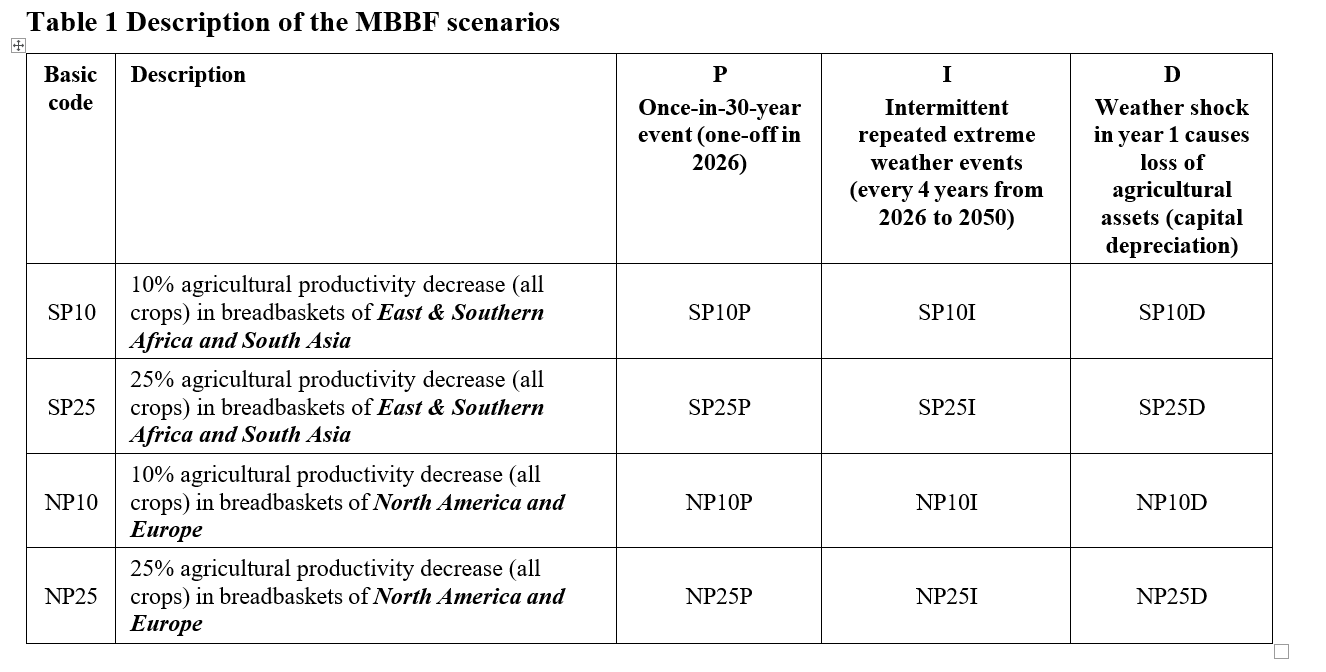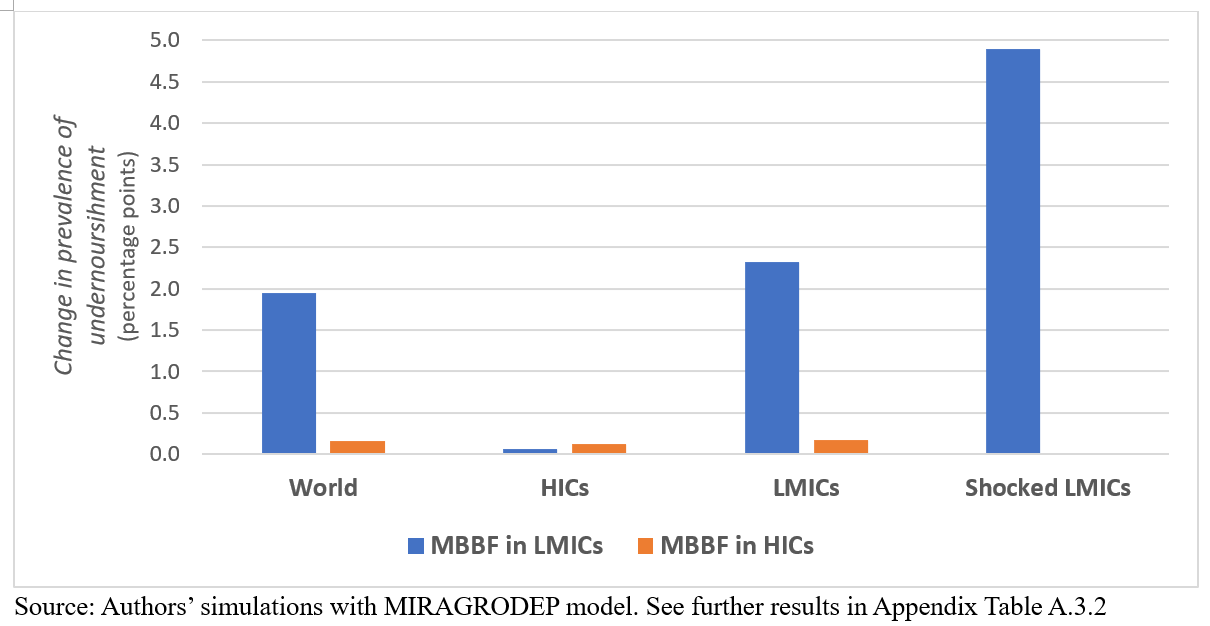Outline
Resources
In a new IFPRI Discussion Paper, IFPRI researchers review the evidence on risks of multiple breadbasket failures (MBBFs) and analyze their potential impacts on global food markets and food security.
Currently, 80% of the world’s people rely on just three agricultural commodities as primary food staples: maize, rice and wheat. Much of the production of these staple foods is concentrated in a small number of countries and regions, frequently identified as “breadbaskets”. Output shocks in these countries have historically been correlated, contributing to large global output shocks. Such extreme weather events have already posed serious threats, often affecting multiple producing areas. The 1982-83 El Niño event saw maize yields in Southern Africa fall by over 70% between 1981 and 1983. Severe droughts in 1983 caused US maize yields to fall by close to 30% while global yields dropped by 11%. More recently, in 2022 half of the European continent was under official drought warnings following a summer of heatwaves, resulting in record low water levels and below-average corn and grain yields. At the same time, the United States suffered major agricultural losses caused by droughts, in some cases forcing farmers to sell off their livestock to make up for financial losses from crop failures. Also in 2022, a third of Pakistan was affected by devastating floods, causing a plummeting rice harvest, while India - the world's biggest rice exporter - suffered extreme temperatures and drought shrinking the country's rice farming area in that same year. These events had a major impact on global food supplies and were exacerbated by non-climate driven, geopolitical events notably Russia's invasion of Ukraine, which is one of the world's biggest producers of wheat. This substantially pushed up global food prices, increasing food insecurity risks.
Such multiple breadbasket failures (MBBFs) can increase food insecurity through two main channels. The first is by reducing the output of poor farmers who depend on food production for income. The second is by raising food prices and putting at risk the ability of poor net food buyers to purchase their needs.
A key question for policy responses to these shocks is whether to focus attention on the people adversely affected by higher food prices, or on the producers suffering output losses. Clearly, the answer may depend on whether the output shock is focused on rich or poor countries.
Key findings
Extreme weather–driven harvest failures raise food insecurity in developing regions, trigger uneven global price surges, and demand region-specific responses to protect vulnerable populations and stabilize food systems worldwide.
Food insecurity rises sharply in developing regions
Extreme weather shocks in South Asia and Africa lead to steep increases in hunger and poverty, as falling farm productivity, lost income, and higher food prices hit vulnerable households hardest.
Global food prices surge unevenly across regions
Breadbasket failures in rich countries raise world food prices more, but developing-country shocks cause deeper social impacts—highlighting that the poorest suffer most even from smaller global market shifts.
Recovery and response depend on context
Shocks in developing regions require immediate safety nets and long-term resilience investment, while rich-country crises call for trade coordination and market stabilization to limit ripple effects.
Estimating global food security impacts of MBBFs
In our paper, we compare the global ramifications of two hypothetical multiple breadbasket failures caused by extreme climate events in different regions. The first examines extreme weather shocks in Southern and Eastern Africa and South Asia. The second analyzes the impacts of MBBFs concentrated in North America and Europe. For illustrative purposes we considered crop yield declines in the affected regions of 25% for all crops. We estimate the ex-ante ramifications of such a scenario using IFPRI’s global MIRAGRODEP model, which is well-suited to assess the transmission of agricultural productivity shocks through local and global market channels and implications for household incomes and food security.
MBBF scenario
This study examines Major Breadbasket Failure (MBBF) scenarios to understand how global food security and markets would respond depending on where the failure occurs in high-income regions or in low- and middle-income regions.
Results
1. Effects on Macroeconomics
Source: Martin, Will; Nia, Reza; and Vos, Rob. 2025. Global food security impacts of extreme weather events and occurrence of breadbasket failures. IFPRI Discussion Paper 2360. Washington, DC: International Food Policy Research Institute. https://hdl.handle.net/10568/176642
Click here for the full screen
2. Effects on Food Prices, Consumption and Diets
Source: Martin, Will; Nia, Reza; and Vos, Rob. 2025. Global food security impacts of extreme weather events and occurrence of breadbasket failures. IFPRI Discussion Paper 2360. Washington, DC: International Food Policy Research Institute. https://hdl.handle.net/10568/176642
Click here for the full screen
3. Effects on Farm Sectors
Source: Martin, Will; Nia, Reza; and Vos, Rob. 2025. Global food security impacts of extreme weather events and occurrence of breadbasket failures. IFPRI Discussion Paper 2360. Washington, DC: International Food Policy Research Institute. https://hdl.handle.net/10568/176642
Click here for the full screen
4. Effects on Poverty and Food Security
Source: Martin, Will; Nia, Reza; and Vos, Rob. 2025. Global food security impacts of extreme weather events and occurrence of breadbasket failures. IFPRI Discussion Paper 2360. Washington, DC: International Food Policy Research Institute. https://hdl.handle.net/10568/176642
Click here for the full screen
Food security impacts of MBBFs in high-income countries differ from those in developing countries
Our findings show that MBBFs can lead to substantial increases in global food insecurity and poverty. They also show that these shocks are dramatically more serious if they occur in developing countries where many people are vulnerable to poverty and food insecurity.
An MBBF causing a 25% loss in yields in Eastern and Southern Africa and South Asia would cause an estimated 2 percentage point increase in the global prevalence of undernourishment (compared with the baseline), affecting 160 million more people. In the affected regions, food insecurity could increase between 4 and 10 percentage points, as farm households are hurt by lower output and incomes and other vulnerable households by sharply rising food prices.
Simultaneous shocks to production in the high-income countries in Europe and North America will have large impacts on global staple food prices that indirectly affect households in poor countries. However, we find that these impacts would be much more serious if the extreme weather hits production areas in low- and middle-income countries.
An MBBF in North America and Europe would cause a bigger fall in global incomes and a larger increase in world food prices, as a result of their large weight in the global economy and in international trade. The impact on global food security and poverty would be much more muted, with farm incomes rising in most developing country regions. Countries in Eastern and Southern Africa, however, with many net buyers of food, however, would suffer more poverty and food insecurity in this scenario.
Figure 1 Comparison of food insecurity impacts of MBBFs in HICs and LMICs in the year of the shock, % points
Food systems can rebound rapidly, but lasting damage may remain
A natural disaster may not just cause a temporary decline in agricultural production but sustained reductions from loss of physical and human capital. These losses are perhaps most obvious with livestock grazing systems where livestock inventories can be severely depleted during droughts. Droughts, floods and fires may also cause physical loss of physical and natural capital such as water management systems, buildings, fruit trees and standing timber.
Such capital losses, especially when associated with MBBFs in developing-country regions would exacerbate the impacts on global poverty and food insecurity. Yet, permanent losses may be limited even in these scenarios, if subsequent recovery of agricultural production and gradual recovery of agricultural capital stock
Policies
Our analysis has not, as yet, considered policy responses. Popular responses to adverse climate shocks in the past have included reductions in tariffs on food products in importing countries and the imposition of export bans in shock-affected producer countries. Such responses have exacerbated the magnitude of global food price shocks and further increased price volatility, and worsening food security. In follow-up research, we plan to assess the effects of such trade policy responses, as well as of domestic price insulation measures to inform policy makers of what anticipatory measures would effectively protect the food security of vulnerable populations against global market shocks driven by extreme weather.

